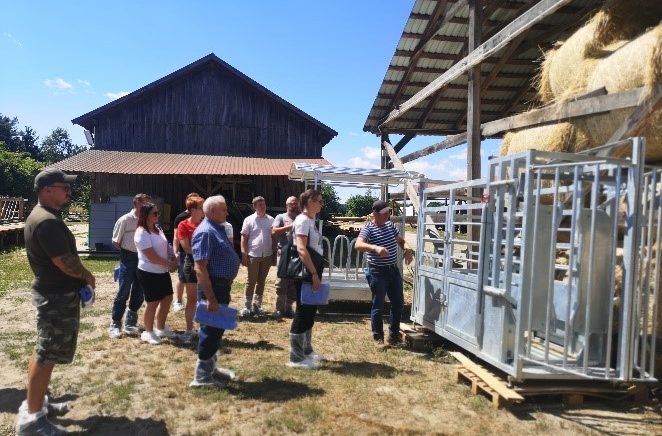A meeting of breeders from the Lower Silesian Voivodeship, as part of a training course at the demonstration farm in Osolin, as part of sub-measure 1.2. “Support for demonstration projects and information activities” implemented under the Rural Development Programme 2014–2020 for “Modern technologies for breeding and raising beef cattle”.
This is the second of the demonstration farms hosting training for farmers from the Lower Silesian Voivodeship. This time, we hosted in the village of Osolin, as part of the implementation of sub-measure 1.2. “Support for demonstration projects and information activities” of the Rural Development Programme 2014–2020, concerning modern technologies for breeding and raising beef cattle. This operation is co-financed by the European Union with funds from the European Agricultural Fund for Rural Development (EAFRD).
The specific topic of the demonstration was “Modern management of beef cattle herd, based on chip information”. As in previous demonstration trainings in the country, the training includes three visits. During the meeting on 18 July 2023, the topic of innovation in beef cattle breeding, based on the possibility to chip cattle and use it in herd management, was addressed. The possibility of using such a system in a herd of Limousin cattle kept on pasture was presented on the farm.
Another objective of the training was to demonstrate the possibilities of using the equipment purchased for the demonstration – including a bale feeder and a restraining chute – in terms of efficient cattle fattening and monitoring weight gains during the grazing season.
During the first visit, the issue of the need to monitor grazing, including weight gain levels in the context of drought, poor pastures and high thermal stress in cattle was raised. The demonstration also touched on the issue of rational water management, as well as model water management, especially during the already present drought.
Mariusz Salandra’s demonstration facility, set up on the Osolin farm (Trzebnica County, Lower Silesian Voivodeship), has 69 ha of grassland, including pastures. The beef herd has approximately 31 head of Limousin dams. The cattle are kept during the grazing season (May to November) around the clock in 10 paddocks, and in winter on deep litter under wooden shelters with an outside yard. Pastures of natural origin are established on arable land. The distance of the pastures from the farm is up to 500 metres. Feeding on the farm is based on pasture, with haylage, hay and straw in winter. Harem mating is based on bulls replaced in the herd every 5 years, and sourced from pedigree breeding. Water is supplied to the facility from a water supply system; during the grazing period on individual paddocks, water is delivered or there is free access to natural watercourses. Beef cattle are chipped and monitored for individual temperature and disease units 24 hours a day, all year round. A herd management system is used on the farm.
This first of three demonstrations included a theoretical and a practical part. In the theoretical part, the meeting leader, Lower Silesian Agricultural Advisory Centre employee Wojciech Karkulowski, discussed aspects of breed selection, effects of crossbreeding, reproductive management of a herd, proper mating dates and the use of artificial insemination in beef herds. The aspect of appropriate selection of breeds for the nature and form of production on a given farm and the benefits arising from this, especially in the context of obtaining F1 hybrids, was discussed. The subject of occupational safety and health on the farm, disease control and prevention was also discussed. Reference was also made to the problem of ASF, which affects many farms that are geared towards two-way production.
In the second part of the theoretical meeting, an employee of the National Research Institute of Animal Production, Dr Piotr Wójcik, Professor of NRIAP, discussed the aspect of innovative technologies used in the management of a beef herd (boluses, tags, chips), including the monitoring of cattle grazing (chips). In particular, he highlighted the potential to increase production levels through planned grassland management, supplementary feeding during the summer season and unrestricted access to roughage (straw, hay) in the outside yard area. The presenter discussed the important role of unrestricted access to water by cattle and 24-hour monitoring of microclimatic conditions in the pasture and barn. This is particularly important in combating the heat stress that can occur during periods of high temperatures and lack of shaded areas for cattle, especially in the pasture.
The topic of small-scale pasture retention and the possibility of using rainwater on the farm and natural watercourses was also discussed.
In the practical part, which took place directly on the farm and in the pasture, by visiting further facilities as well as by observing the grazing herd itself, the participants learned about methods for effective and inexpensive permanent fencing of pastures, the role of mobile fencing systems enabling strip grazing and the rational management of limited pasture resources in times of drought.
The farm owner touched upon the extent of the work he carries out within the segregated paddocks. These include cultivation practices in the form of pasture topping, harrowing and feeding with manure. The aspect of protecting the herd from predators, which are currently causing significant damage to the herd, was also raised. For the next meeting, the effectiveness of using rolling fencing systems in the pasture and the monitoring of animal behaviour were set for demonstration.


